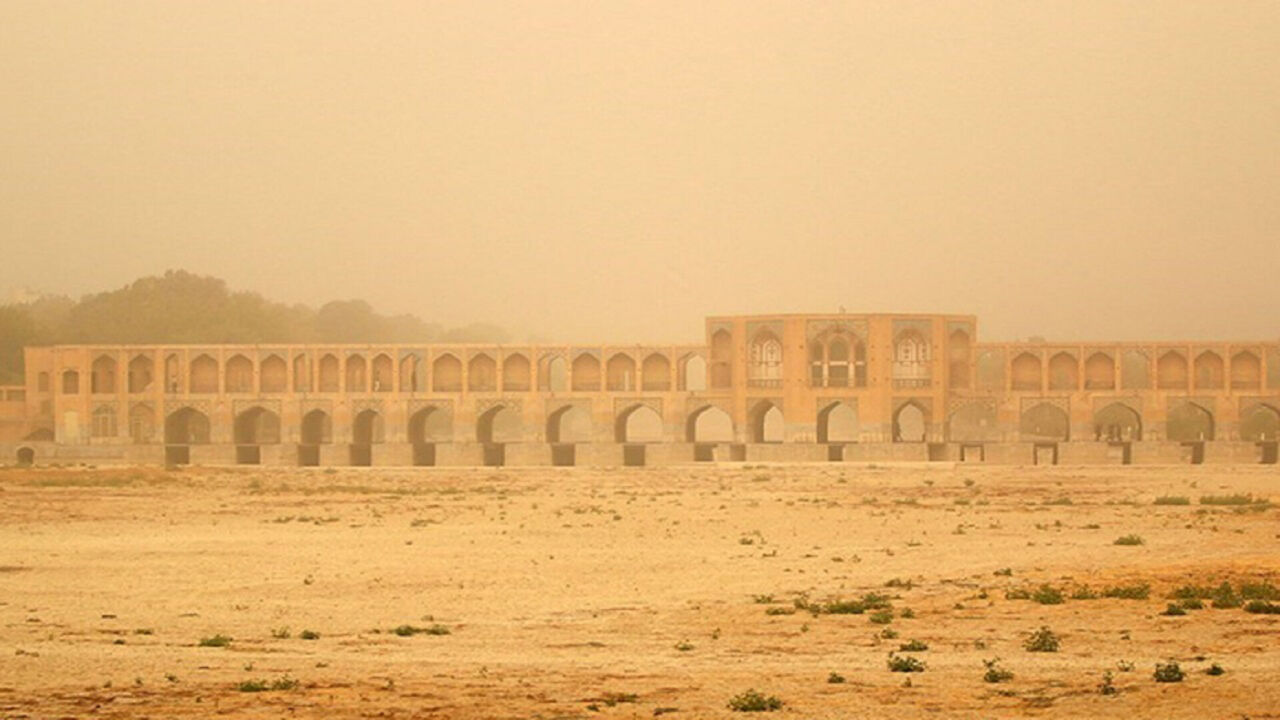Iran’s Water Crisis Could Turn Tehran into a Ghost City
The Khaju Bridge (Pol-e Khāju) in Isfahan, Iran, when the Zayanderud riverbed is dry | Picture Credits: Islamic Republic News Agency
This article is co-authored by Ammar Goli and Kawe Fatehi
Years ago, former Minister of Agriculture, Isa Kalantari, warned that Iran’s water crisis and droughts are “more dangerous than any foreign enemy.” Today, Iran’s water shortage has become a humanitarian, political, and security issue.
Decades of mismanagement combined with worsening climate change have plunged Iran into dangerous levels of water scarcity, turning a potential environmental catastrophe into social unrest and a geopolitical crisis.
The overuse of water resources, unsustainable policies in agriculture, and water transfer strategies have drained Iran’s water reserves. The combination of these problems is now leading to a potential cataclysm as land subsidence and the loss of underground water cause population displacements and worsening social crises.
Tehran’s Existential Crisis
The diminishing resources in Iran’s central plateau has forced many residents to move to other provinces– though the situation is not much better elsewhere, as water has become a country-wide issue.
The internal displacement is destabilizing the population and leading to worsening food security.
Many who move ultimately end up in the capital Tehran – with a population of about 14 million now – which has long been the most common destination for climate and economic migrants.
The issue now facing the historic city, however, is the limited resources and underdeveloped infrastructure, which at the time of writing is facing unprecedented pressure, as only a small portion of Tehran’s dam reserves and other water sources remain.
In an exclusive interview with The Amargi, an official from the Tehran governorate’s office said, “The capital’s infrastructure has crossed the limit of tolerance. At the current rate, Tehran will not be able to provide its vital needs in the next two years,” He warned. “If migration is not controlled or the change of capital city [as Iranian president Pezeshkian has suggested] is not seriously considered, we will face a broad and unprecedented societal crisis.”
Cities on the peripheries of Iran have seen a more aggravated side of the water crisis.
In the Baluch-dominated southeastern province of Sistan & Baluchestan, which borders the Gulf of Oman, a significant portion of its population lacks access to sustainable drinking water. This is while water transfer projects transport water from the Gulf of Oman to the Persian-dominated regions in the center of the country.
The unsustainable water practices have also left a clear mark on the country’s Kurdish and Azeri-dominated regions. Lake Urmia in the northwest of Iran, once the largest lake in the Middle East, is now drying up. And in the process, agriculture in the region is taking a major hit as water is rerouted elsewhere.
This pattern of resource allocation, which prioritizes the interests of powerful regions over local needs, has had severe consequences. It has not only caused the collapse of local economies and forced migration, but also added to the long-running pattern of systemic discrimination against ethnic and religious minorities in Iran.
Nikahang Kowsar, a water journalist and geologist, told The Amargi that the root of the water crisis in Iran is “mismanagement, not a lack of natural resources.” He added, “Iranians have been able to preserve groundwater aquifers for thousands of years in a dry land.”
He believes that the destruction of the traditional methods in the recent decades – methods that had worked with Iran’s topographic and demographic specificities – is due to “Decisions that lack scientific foundations” and “because of a lack of accountability”. Kowsar argued that the way out of the crisis lies not in importing technology, but in reforming management, returning to eco-oriented management, and institutional transparency.
The Regime’s Role in the Crisis
According to information received by The Amargi from the Tehran official, there have been warning reports from both the Ministry of Interior and the Ministry of Intelligence. They have raised their concerns to the National Security Council regarding the threat of renewed violence due to water crises and droughts in the provinces of Alborz, Qazvin, Isfahan, as well as Tehran. Worth noting: water scarcity was among the leading causes of the nationwide uprisings of both 2017 and 2019, resulting in hundreds of fatalities and mass detentions.
The Iranian government’s inaction on the issue has not gone unnoticed. While domestically, people are struggling to meet their water needs, outside of Iran’s borders, Israeli officials have sought to highlight the government’s failures and take advantage of the vulnerable position in which the Islamic Regime has placed itself.
Sitting in the polar opposite position to Tehran, Tel Aviv has used its technical and managerial capabilities in water management and wastewater recycling to meet the water needs of its population sustainably. They have increased the country’s desalination capacity continuously – something which the Iranian government is now attempting to do. Israel’s success with water is a key to branding itself as a model for crisis management.
In a video message in August 2025, Netanyahu said, “Israel is ready to help Iran solve its water crisis after it is free from the regime.”
Commenting on the topic, Nikahang Kowsar said, “What enables Israel to present itself as an efficient model in its water management and to portray the Iranian crisis as an indication of structural inefficiency lies in the differences in performance.” Kowsar emphasized that the relevance of comparison becomes effective if society is dismayed by its institutions’ performance, in which case “the lack of trust in domestic institutions will occasionally lead people to resort to outsiders as saviors in a time of crisis.”
Amid social unrest that has continued since the Woman, Life, Freedom protests and food insecurity, the narrative serves as a tool to influence Iran’s public opinion.
History of the Issue
Although the Islamic Regime’s mismanagement has brought the issue to existential levels, the roots of the water crisis go back to the Pahlavi regime, who ruled Iran from the 1920s until the 1979 Revolution. In the second half of the 20th century, the Pahlavis enlisted foreign help to modernize Iran’s water infrastructure, which led to major changes in how Iran used and distributed water.
These changes led to an increase in well-drilling and the overuse of underwater reserves at a rate too extreme for it to be naturally replenished or remain sustainable. Among other changes, it also led to the termination of the qanat system, which had been in use for centuries beforehand.
Referring to this period, Kowsar said, “The change in approach to water management, without considering local capacities and climatic constraints, paved the way for the excessive use of underground resources.” He argued that “the lack of environmental assessment and excessive reliance on imported projects took Iran’s water management path out of historical balance and formed the foundations of today’s crisis.”
The Road to Cataclysm
Iran is not the only country in the region that faces a growing water shortage. To the west, neighboring Iraq has faced similar issues, leading to loss of major sections of the Mesopotamian Marshes and record-low water volume in the Tigris River. In the east, Afghanistan has also prepared for the eventuality of a water shortage, and has now decreased the flow of water that used to stream into Iran in a bid to increase its own dam reserves.
Security agencies now fear a new wave of discontent will start in the areas around Tehran and Karaj, like in 2019, The Amargi’s source in Tehran’s governorate said. Hundreds of thousands of residents in dry and water-scarce provinces have migrated to these areas over the past decade, and they are now living in an uncertain economic and life state.
In the past two decades, water has gone from an environmental issue to becoming a driving factor for political change in the Middle East, just as droughts in Syria and North Africa sparked major social crises. But even such major crises might be better than the alternative scenario: Tehran and other major cities becoming uninhabitable.
Ammar Goli
Ammar Goli is an investigative reporter whose work focuses on the relationships between mafia groups and totalitarian governments, and on the Kurdish issue in the Middle East. He has contributed to various media outlets, including BBC Farsi, Iran International, and Radio Ferda, in Persian, Kurdish, and German, drawing on his deep understanding of the political and social dynamics of the region. At The Amargi, he writes specifically about East Kurdistan and Iran, offering valuable insights and analysis of current events.




